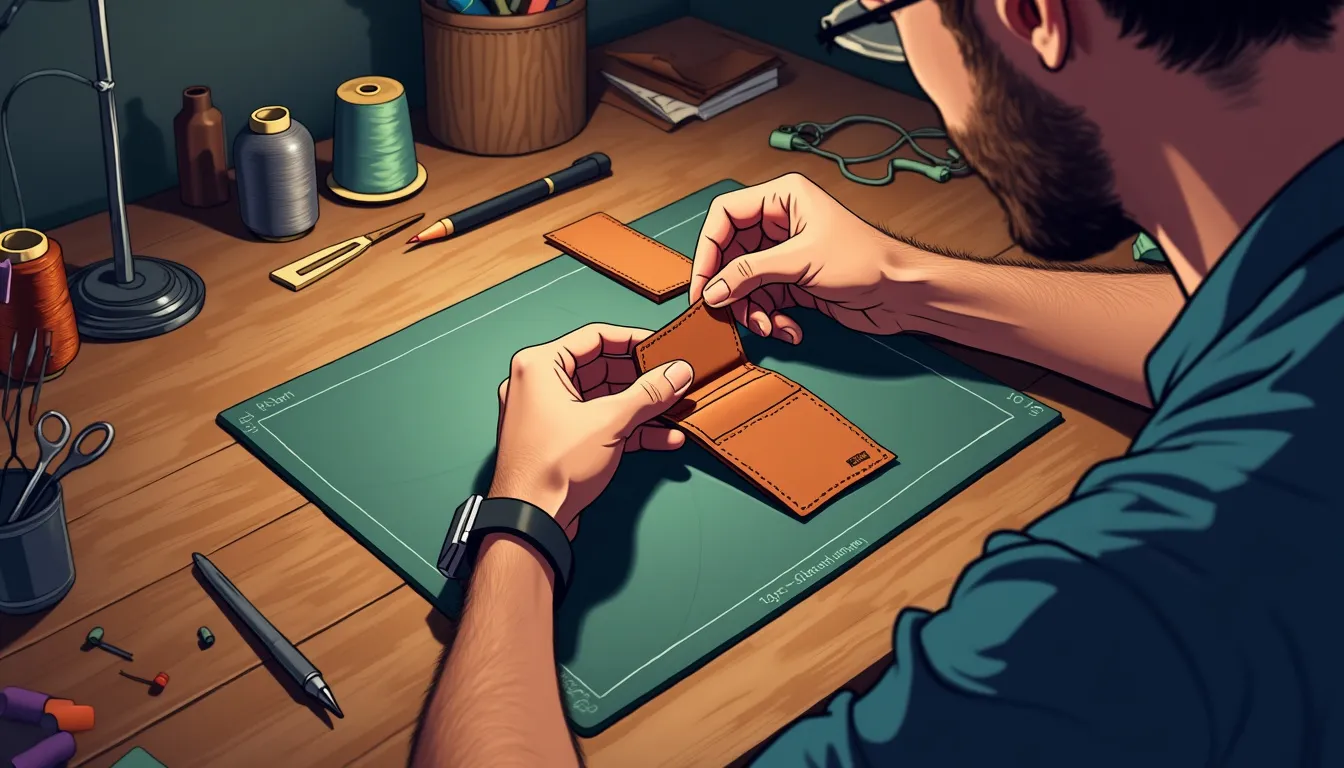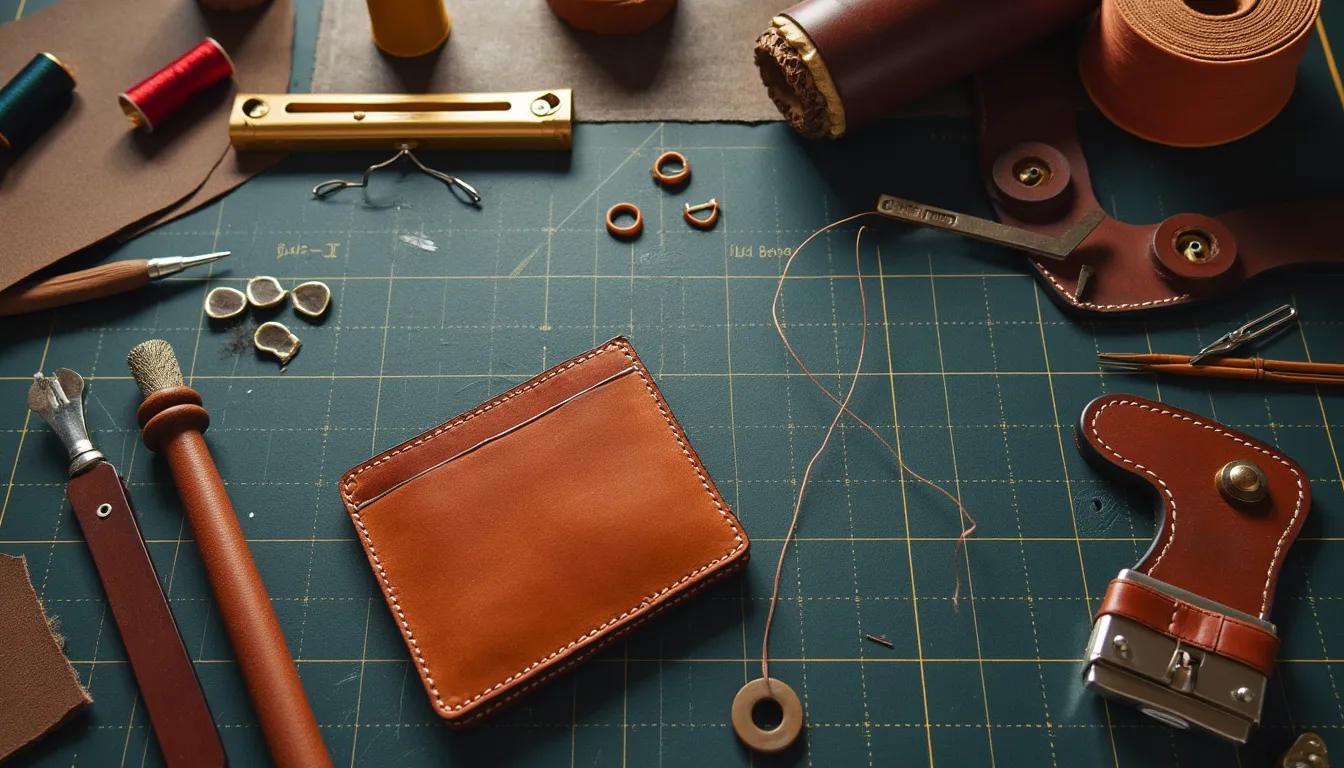In a world increasingly dominated by mass-produced goods, the timeless art of leatherworking brings an unparalleled sense of satisfaction and personal achievement. For those looking to immerse themselves in a craft that marries functionality with artistry, DIY leatherwork projects offer an excellent starting point. The allure of leatherwork lies not just in creating beautiful, durable items, but also in the delight of crafting something uniquely your own.
Embarking on this creative journey doesn’t require a background in craftsmanship; all it takes is a willingness to learn and a few essential tools and materials. Whether you’re attracted to the idea of crafting a bespoke wallet, a chic bracelet, or a custom keychain, beginning with beginner-friendly projects ensures you build foundational skills without overwhelming complexity.
To get started, it’s crucial to familiarize yourself with the essential tools and materials. Basic leatherwork tools include a utility knife, a ruler, a hole punch, and needles and thread specifically designed for leather. The material itself comes in various types and qualities, but for beginners, vegetable-tanned leather is highly recommended due to its versatility and ease of use.
Getting hands-on with simple, practical projects not only hones your skills but also leads to quicker, tangible results, bolstering your confidence to take on more challenging endeavors. Moreover, proper safety measures while handling sharp tools and maintaining the leather will help you enjoy the process without any setbacks.
From my own years of experience navigating the delicate balance between perfectionism driven by OCD and the creative chaos spurred by ADHD, I know first-hand the therapeutic value of structured, hands-on activities like leatherworking. Just as I’ve found ways to channel my focus and manage distractions, you’ll discover that each project brings not only a finished item but also a sense of accomplishment and relaxation, proving that DIY leatherwork projects for beginners can be a deeply rewarding pursuit.
Now, as you prepare to choose your first project and step into this fulfilling craft, remember that patience and practice are your best allies. Dive in with enthusiasm, and let each cut and stitch be a step towards crafting your personal masterpieces.
Introduction to DIY Leatherwork for Beginners
Leatherworking is a time-honored craft that combines artistry, craftsmanship, and functionality. For many, the appeal of DIY leatherwork projects lies in creating something unique and personalized. From wallets and belts to more intricate designs like purses and laptop sleeves, leatherworking lets you turn raw materials into tangible, usable art. However, diving into leathercraft can be daunting, especially when confronted with a plethora of tools, techniques, and materials.
Starting with beginner-friendly projects is crucial to building your confidence and skills in leatherworking. It allows you to familiarize yourself with the basic techniques and gradually take on more complicated tasks as you go. Beginner projects typically require fewer tools and simpler patterns, making them ideal for those just dipping their toes into this satisfying hobby.
Now, let’s delve into the essential tools and materials you’ll need to get started with DIY leatherwork projects for beginners. Having the right tools not only makes the process smoother but also ensures a higher quality finish. To embark on your leatherworking journey, you will need some fundamental items:
- Leather: Vegetable-tanned leather is an excellent choice for beginners due to its ease of use and versatility. It can be dyed, tooled, or left in its natural state, giving you a range of creative options.
- Cutting Tools: A sharp utility knife or a rotary cutter will help you make clean, precise cuts. A cutting mat is also essential to protect your work surface and tools.
- Ruler and Square: Accurate measurements are vital in leatherwork. A metal ruler paired with a square will ensure your cuts and designs are straight and precise.
- Punches: Hole punches of various sizes are necessary for creating holes for stitching, rivets, and other fasteners. A punch set often includes different sizes to accommodate various project needs.
- Stitching Supplies: Waxed thread and stitching needles specifically designed for leather will facilitate the sewing process. An overstitch wheel or stitching chisel can also help you mark even stitch lengths.
- Mallet or Maul: Used in conjunction with punches and chisels, a mallet or maul is crucial for transferring enough force without damaging your tools or leather.
- Edge Tools: An edge beveler and burnisher will help you create smooth and rounded edges, giving your projects a professional finish.
These are just the basic tools needed for most DIY leatherwork projects for beginners, but as you progress, you may find yourself adding more specialized tools to your arsenal. The key is to start simple, master the basics, and then gradually explore more complex techniques and tools.
As someone who has navigated the challenges of ADHD and OCD, I’ve found that leatherworking provides a wonderful outlet for creativity and focus. The structured yet flexible nature of leathercraft can be particularly therapeutic, allowing you to channel energy into something productive and beautiful. And if you’re on a weight loss journey like I am, consider leatherworking a low-impact activity that keeps your hands busy and your mind engaged, reducing the likelihood of idle snacking.
By focusing on beginner-friendly projects, you’ll set yourself up for success, minimizing frustrations and maximizing satisfaction. Remember, every expert in leatherwork started as a novice. With the right tools, materials, and mindset, you’ll be well on your way to creating stunning leather pieces that you can be proud of.
So grab your tools, choose your leather, and let’s get started on your first DIY leatherwork project!

Choosing Your First Leatherwork Project
Embarking on your first leatherwork project can be both exciting and intimidating. The key to a successful experience lies in selecting the right project that aligns with your skill level and the tools you have on hand. For beginners diving into the world of leather crafting, it’s crucial to choose a project that is both manageable and rewarding.
Types of Beginner Projects
When considering DIY leatherwork projects for beginners, there are several types of projects that act as great starting points. These include:
- Keychains: Simple and functional, keychains require minimal leather and tools. They’re perfect for practicing basic techniques like cutting, punching, and stitching.
- Simple Wallets: A step up from keychains, wallets are functional items that introduce more complex stitches and pattern-cutting.
- Bracelets: Leather bracelets offer a creative outlet without overwhelming the beginner. They often involve straightforward measurements and can be personalized with unique designs or hardware.
Factors to Consider When Selecting a Project
Selecting the right project involves a few considerations to ensure a positive crafting experience. These factors include:
- Skill Level: Analyze your current skill set honestly. If you’re new to working with leather, opting for projects like keychains or basic bracelets can help build confidence before moving on to more complex creations such as wallets.
- Tools Required: Different projects demand varying tools. Beginner-friendly projects typically need basic tools like a utility knife, leather punch, needles, and thread. Ensure you have the necessary tools before starting a project.
- Time Commitment: Some projects can be completed quickly, while others might take several hours. Choose a project that fits your schedule and allows for thoughtful, unhurried work.
- Materials: The quality and type of leather you use can impact your project. For beginners, it’s recommended to use vegetable-tanned leather, which is easier to work with and forgiving when it comes to errors.
Safety Tips for Handling Leather and Tools
Safety is paramount when working with leather and the various tools involved in crafting. Here are some important tips to keep in mind:
- Proper Tool Use: Always use tools as intended and ensure they are in good condition. Sharp blades, in particular, should be handled with care to prevent serious injuries.
- Workspace Organization: Keep your workspace tidy to avoid accidents. Clearly separate work materials from tools, and always place sharp objects securely when not in use.
- Personal Protective Equipment (PPE): Consider wearing gloves to protect your hands from cuts and abrasions. Safety goggles can also be useful to shield your eyes from debris.
- Precision and Patience: Leatherwork requires precision. Rushing through tasks can result in mistakes and injuries. Take your time to measure, cut, and stitch accurately.
- Storage and Maintenance: Store your tools properly and maintain them well. Regularly sharpen blades and clean other tools to prevent rust and damage.
By thoughtfully selecting and approaching your first project with these factors in mind, you’ll set a strong foundation for future DIY leatherwork projects for beginners. Remember, the goal is to enjoy the process, learn new skills, and create something beautiful and functional.

Step-by-Step Guide to a Basic Leatherwork Project
Embarking on DIY leatherwork projects for beginners can be immensely rewarding. Let’s delve into the detailed steps of creating a leather keychain, a perfect starting point to hone your skills.
Preparing Your Workspace
Before you start your leatherworking project, it’s essential to set up a well-organized workspace. Choose a flat, sturdy surface, like a workbench or a table, where you can comfortably handle your materials and tools.
Ensure you have ample lighting to avoid straining your eyes. Gather all your tools: a cutting mat, craft knife, ruler, leather punch, thread, needle, and a few clamps. Keep your materials handy, including your chosen piece of leather and keychain hardware.
Don’t forget to wear protective gear, like gloves and safety glasses, to keep yourself safe. As someone who has navigated the nuances of safety and productivity, I can’t stress enough the importance of a well-prepared and safe workspace. Personally, dealing with ADHD and OCD, my workspace’s orderliness is a game-changer in maintaining focus.
Cutting the Leather
Now that your workspace is ready, let’s move on to cutting the leather. Measure and mark your leather piece according to the desired dimensions of your keychain. A typical keychain might be around 3 to 4 inches long and 1 inch wide.
Using a ruler and a pencil, draw the cutting lines on the flesh side (the rougher side) of the leather. Place the leather on the cutting mat, align your ruler along the cutting line, and firmly hold it in place. With your craft knife, make continuous, steady cuts along the marked lines. Remember, patience is key here; rushing may lead to uneven edges or mistakes.
Pro Tip: Utilize a rotary cutter for an even smoother and more precise cut. It works wonders, especially if you’re still mastering your knife-handling skills.
Punching Holes and Sewing
Next, we proceed to punch holes for sewing. Align the keychain hardware at one end of your leather strip and mark where the holes need to be punched for attaching it. Typically, two small holes spaced about 0.5 inches apart should suffice.
Using your leather punch, carefully create the holes at the marked spots. If you’re using a rotary punch, select the appropriate size that matches your needle and thread. Push the punch through the leather with consistent pressure until it cuts cleanly through.
Thread your needle with a length of waxed thread. A length measuring about three times the perimeter of your project should be ample. Begin sewing by passing the needle through one hole, pulling the thread nearly all the way through, and leaving a small tail. Stitch back through the opposite hole, creating a loop that holds your keychain hardware securely in place.
Continue stitching using the saddle stitch method, which involves two needles and ensures strong, durable seams. Once you complete stitching, tie the thread ends securely and trim any excess thread.
Finishing Touches and Care
With the sewing complete, it’s time for the final touches. To give your keychain a sleek, polished look, burnish the edges. Moisten the edges slightly with water or edge finishing compound, then use a burnishing tool to rub along the edges briskly until they appear smooth and shiny.
Next, apply a leather conditioner to keep the leather supple and protected. Simply dab a small amount onto a cloth and rub it into the leather in circular motions.
Finally, attach your keychain hardware and ensure it is secure. Your DIY leather keychain is now ready for use! Regularly check for signs of wear and reapply conditioner as needed to maintain its longevity.
Visual Aids and Diagrams
Here are simple, visual steps to guide you:
- Step 1: Set up your workspace with all tools and materials arranged neatly.
- Step 2: Measure and mark your leather for cutting.
- Step 3: Cut the leather along the marked lines.
- Step 4: Punch holes for attaching the keychain hardware.
- Step 5: Sew the keychain using the saddle stitch method.
- Step 6: Burnish edges and apply leather conditioner.
- Step 7: Attach the keychain hardware and verify its security.
With these detailed steps and visual aids, you are well-equipped to embark on DIY leatherwork projects for beginners. Trust me, the satisfaction of holding a finished product, crafted with your own hands, is unmatched. So, roll up your sleeves and start creating!

Tips for Successful Leatherwork and Next Steps
Embarking on DIY leatherwork projects for beginners is both exciting and fulfilling. However, like any craft, leatherworking comes with its share of challenges. Here, we’ll discuss some common mistakes to avoid, tips for improving your skills, and how to advance to more complex projects. Finally, we’ll point you toward valuable resources for further learning and inspiration.
Common Mistakes to Avoid
One of the most frequent pitfalls for beginners is neglecting preparation. Before you cut a piece of leather or stitch a single seam, ensure you have all your tools and materials ready. This practice will save you time and reduce errors. I remember working on my first leather wallet and neglecting to use the proper measurements; the result was less than ideal.
Another mistake is impatience. Leatherwork demands a certain level of patience and attention to detail. Rushing through steps can lead to skewed stitching or uneven cuts. One technique that has helped me is setting a timer for each task, which allows me to focus without feeling overwhelmed by the project’s entirety.
Lastly, understating the importance of protective gear can be a critical error. Always wear safety gloves when using sharp tools like rotary cutters or knives. Even experienced leatherworkers can have unfortunate slips, and safety should always be your priority.
Tips for Improving Your Leatherworking Skills
Practice, practice, practice! The more you work with leather, the more comfortable you will become. Start with small pieces, experimenting with different stitches and cuts. Over time, these basic skills will become second nature.
Avoid the temptation to rely solely on online tutorials. While these are invaluable, joining a local leatherworking group or class can offer personalized feedback and hands-on experience. Interacting with fellow enthusiasts can provide insights you won’t find online.
Invest in quality tools. As a beginner, it’s understandable to start with affordable options, but upgrading your tools can make a significant difference in your work. For instance, a high-quality awl or rotary cutter will offer more precision and ease of use.
Advancing to More Complex Projects
After you’ve completed a few beginner projects, you might feel ready to tackle more complex pieces. Start with something moderately challenging, like a cardholder or a small bag. These projects often involve multiple steps, such as assembling several pieces or incorporating advanced stitching techniques.
I recall my transition to more intricate projects through a leather journal cover. This project involved multiple layers, intricate stitching, and careful measurements. It was a significant leap from simpler items, but the experience was incredibly rewarding and educational.
Document your progress. Taking photos and notes of each project can be beneficial. You’ll be able to see your improvement over time and identify areas for future focus. Plus, sharing your work on social media or leatherworking forums can open doors to constructive criticism and new ideas.
Resources for Further Learning and Inspiration
Many resources are available to help you refine your skills further and explore new techniques. Here are a few recommendations:
- Books: Leathercraft: Traditional Handworked Leather Projects by Nigel Armitage and The Leatherworking Handbook by Valerie Michael are excellent starting points.
- Online Courses: Websites like Udemy and Craftsy offer detailed courses on various leatherworking techniques, often taught by professionals in the field.
- YouTube Channels: Channels like Corter Leather and Ian Atkinson provide thorough tutorials and occasional live streams where you can ask questions in real time.
Leatherworking Forums: Joining forums like Leatherworker.net can connect you with a community of enthusiasts who share tips, patterns, and feedback.
By avoiding common mistakes, continuously practicing, and gradually advancing to more challenging projects, you’ll enhance your leatherworking skills in no time. Leverage these valuable resources to stay inspired and informed as you continue your journey in DIY leatherwork projects for beginners.
Embarking on the journey of DIY leatherwork projects for beginners can be both an enriching and creatively fulfilling experience. From the initial excitement of choosing your first project to the meticulous process of cutting, stitching, and finishing your creation, each step offers a unique blend of challenge and satisfaction. As you’ve seen, starting with simpler projects like keychains and bracelets allows you to build confidence and refine your skills in a manageable way.
The importance of preparing a safe and organized workspace cannot be overstated. Handling sharp tools and treating leather with the care it requires not only ensures the quality of your final product but also your well-being as an artisan. In our step-by-step guide, we walked through the foundational techniques crucial for any beginner, emphasizing the process of cutting leather, punching holes, and sewing—essential skills that will serve as the bedrock for more complex projects in the future.
As you navigate through your initial projects, it’s perfectly normal to encounter a few hiccups. Mistakes are part of the learning process; they offer invaluable lessons and pave the way for improvement. Remember, leatherwork is as much about patience and perseverance as it is about precision. By taking note of common pitfalls and actively seeking out tips to refine your skills, you can steadily transform your craft from novice to noteworthy.
Moreover, the resources for advancing beyond beginner projects are abundant. Engaging with online tutorials, joining forums, or even taking a course can provide further insights and inspiration. Don’t hesitate to challenge yourself with more intricate designs as your confidence grows. Every new project is an opportunity to push your boundaries and elevate your craft.
In conclusion, DIY leatherwork projects for beginners offer a rewarding gateway into the world of leather crafting. By starting with simple, structured projects, prioritizing safety, and committing to continuous improvement, you’ll find that each creation becomes a testament to your burgeoning skill set. So, gather your tools, choose your leather, and let your creativity take the lead. Happy crafting, and remember: every master was once a beginner. Dive in, make mistakes, learn, and most importantly, enjoy every stitch of the journey.
Support Us: Check out our recommended products on Amazon.

